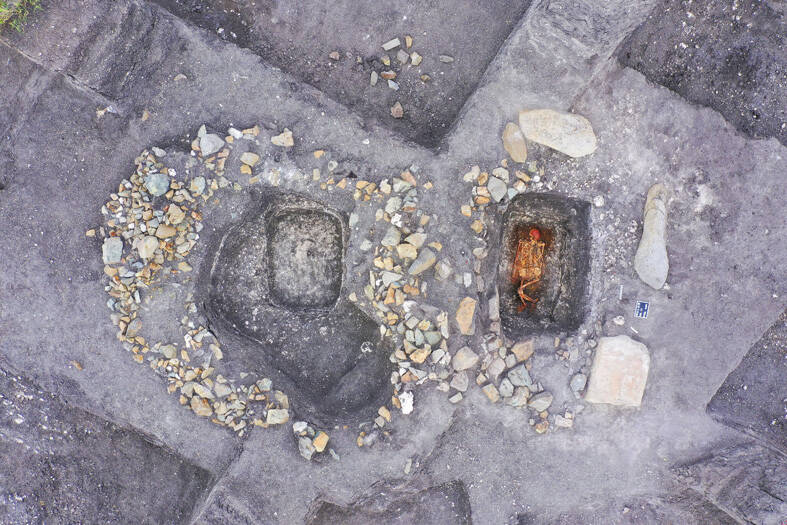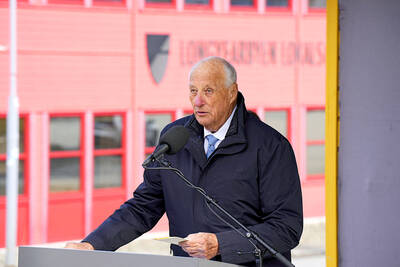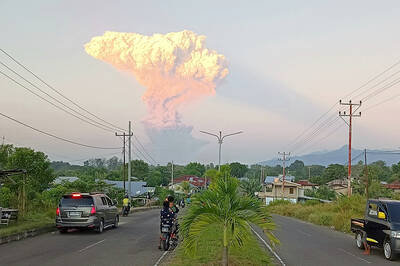Archeologists have found the earliest direct evidence for horseback riding — an innovation that would transform history — in 5,000-year-old human skeletons in central Europe.
“When you get on a horse and ride it fast, it’s a thrill — I’m sure ancient humans felt the same way,” said David Anthony, a coauthor of the study and professor emeritus of anthropology at Hartwick College.
“Horseback riding was the fastest a human could go before the railroads,” he added.

Photo: AP
Researchers analyzed more than 200 Bronze Age skeletal remains in museum collections in Bulgaria, Poland, Romania, Hungary and the Czech Republic to look for signs of what coauthor and University of Helsinki anthropologist Martin Trautmann calls “horse rider syndrome” — six tell-tale markers that indicate a person was likely riding an animal, including characteristic wear marks on the hip sockets, thigh bones and pelvis.
“You can read bones like biographies,” said Trautmann, who has previously studied similar wear patterns in skeletons from later periods when horseback riding was well-established in the historical record.
The researchers focused on human skeletons — which are more readily preserved than horse bones in burial sites and museums — and identified five likely riders who lived about 4,500 to 5,000 years ago and belonged to a Bronze Age people called the Yamnaya.
“There is earlier evidence for harnessing and milking of horses, but this is the earliest direct evidence so far for horseback riding,” said Alan Outram, a professor of archeological science at the University of Exeter who was not involved in the research, but praised the approach.
The study was published on Friday in the journal Science Advances.
Domesticating wild horses on the plains of Eurasia was a process, not a single event, the researchers said.
Archeologists have previously found evidence of people consuming horse milk in dental remains and indications of horses controlled by harnesses and bits dating back more than 5,000 years, but that does not necessarily indicate that the horses were ridden.
The Yamnaya culture, known for its characteristic burial mounds, originated in what is now part of Ukraine and western Russia, an area called the Pontic Caspian steppe. The horses they kept were distinct from modern horses — likely more easily startled and less tolerant of humans — although they might have been the immediate genetic ancestors of modern horses, which emerged a few centuries later, the researchers said.
The Yamnaya are most significant because of their dramatic expansion across Eurasia in only a few generations — moving westward to Hungary and eastward to Mongolia, coauthor and University of Helsinki archeology professor Volker Heyd said.
“The spread of Indo European languages is linked to their movement, and they reshaped the genetic make-up of Europe,” he said.
Their relationship with horses might have partly enabled this stunning movement, the researchers said.
“Horses expand the concept of distance — you begin to think about places previously out of reach as being reachable,” Anthony said.
That does not mean the Yamnaya people were warriors on horseback, as the horses they rode were likely too skittish for stressful battlefield situations, he said.
However, horses might have allowed the Yamnaya to more effectively send communications, build alliances and manage the herds of cattle that were central to their economy.
As only a small percentage of the skeletons studied clearly showed all six markers of riding horseback, “it seems that a minority of the people at that time were riders — that does not suggest that a whole society was built on horseback riding,” said molecular archeologist Ludovic Orlando, who is based at the Centre for Anthropobiology and Genomics of Toulouse in France and was not involved in the research.
Still, he praised the work for helping to better pinpoint the potential genesis of horseback riding.
“This is about the origins of something that impacted human history like only a few other things have,” Orlando said.

Former Nicaraguan president Violeta Chamorro, who brought peace to Nicaragua after years of war and was the first woman elected president in the Americas, died on Saturday at the age of 95, her family said. Chamorro, who ruled the poor Central American country from 1990 to 1997, “died in peace, surrounded by the affection and love of her children,” said a statement issued by her four children. As president, Chamorro ended a civil war that had raged for much of the 1980s as US-backed rebels known as the “Contras” fought the leftist Sandinista government. That conflict made Nicaragua one of

BOMBARDMENT: Moscow sent more than 440 drones and 32 missiles, Volodymyr Zelenskiy said, in ‘one of the most terrifying strikes’ on the capital in recent months A nighttime Russian missile and drone bombardment of Ukraine killed at least 15 people and injured 116 while they slept in their homes, local officials said yesterday, with the main barrage centering on the capital, Kyiv. Kyiv City Military Administration head Tymur Tkachenko said 14 people were killed and 99 were injured as explosions echoed across the city for hours during the night. The bombardment demolished a nine-story residential building, destroying dozens of apartments. Emergency workers were at the scene to rescue people from under the rubble. Russia flung more than 440 drones and 32 missiles at Ukraine, Ukrainian President Volodymyr Zelenskiy

COMPETITION: The US and Russia make up about 90 percent of the world stockpile and are adding new versions, while China’s nuclear force is steadily rising, SIPRI said Most of the world’s nuclear-armed states continued to modernize their arsenals last year, setting the stage for a new nuclear arms race, the Stockholm International Peace Research Institute (SIPRI) said yesterday. Nuclear powers including the US and Russia — which account for about 90 percent of the world’s stockpile — had spent time last year “upgrading existing weapons and adding newer versions,” researchers said. Since the end of the Cold War, old warheads have generally been dismantled quicker than new ones have been deployed, resulting in a decrease in the overall number of warheads. However, SIPRI said that the trend was likely

Indonesia’s Mount Lewotobi Laki-Laki yesterday erupted again with giant ash and smoke plumes after forcing evacuations of villages and flight cancelations, including to and from the resort island of Bali. Several eruptions sent ash up to 5km into the sky on Tuesday evening to yesterday afternoon. An eruption on Tuesday afternoon sent thick, gray clouds 10km into the sky that expanded into a mushroom-shaped ash cloud visible as much as 150km kilometers away. The eruption alert was raised on Tuesday to the highest level and the danger zone where people are recommended to leave was expanded to 8km from the crater. Officers also